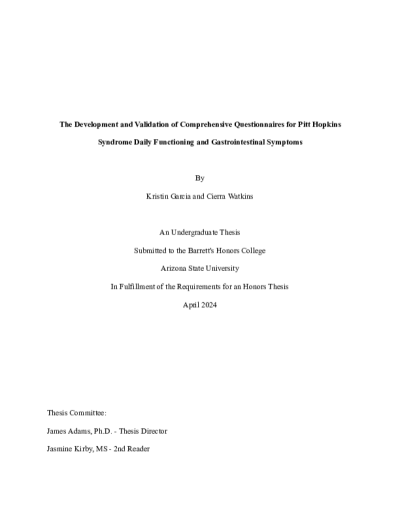
Sulfate deficiency is seen in children with autism through increased urinary excretion of sulfate and low plasma sulfate levels. Potential factors impacting reduced sulfation include phenosulfotransferase activity, sulfate availability, and the presence of the gut toxin p-cresol. Epsom salt baths, vitamin supplementation, and fecal microbiota transplant therapy are all potential treatments with promising results. Sulfate levels have potential for use as a diagnostic biomarker, allowing for earlier diagnosis and intervention.
The Healthy Pregnancy Summit is a collection of videos from a variety of specialists detailing how to have a healthy pregnancy and healthy child, based on the latest scientific and medical information. This project summarizes each presentation, and compares to the Healthy Child Guide, a document supplementary to the summit. Finally, this project analyzes the overall usefulness of the summit and each presentation, and suggests areas for improvement.

Methods: The Eye to Eye mentorship program assessed involved mentors and mentees who completed 12 in-person art sessions out of the normal 20 in-person sessions. The first main assessment was the BLD (Breger Learning Difference) Feedback Survey addressing one’s experience in the Eye to Eye program and which were completed at the end of the mentorship program and filled out by mentors, mentees, and mentees parents (one parent for each mentee). A total of 12 mentors, 6 mentees, and 6 mentee parents were included in the feedback survey final analysis. The second main assessments were the pre and post Behavior Assessment System for Child, Third Edition (BASC-3) provided to mentors, mentees, and mentees parents (one parent for each mentee). A total of 10 mentors, 5 mentees, and 5 mentee parents were included in pre and post BASC-3 final analysis. Fall 2019 (pre) and Spring 2020 (post) optional interviews involved 5 mentors and 3 mentees who showed interest and were comfortable participating with additional release forms.
Results: The program was generally positively rated in the feedback survey by mentors, mentees, and mentee parents. The highest responses for mentors, mentees, and mentee parents all incorporated average ratings of 4.0 or higher (out of 5.0) for perceived understanding of socio-emotional skills after Eye to Eye, experience in Eye to Eye, how having a mentor or mentee made them feel, and perceived change in self-awareness. All three groups reported fairly high ratings of improved self-awareness of 4.0/5.0 or above. No negative ratings were provided by any participants and the lowest response was no change. The BASC-3 evaluation found statistically significant improvement in mentors’ anxiety and atypicality and mentees’ sense of inadequacy.
Discussion: The Eye to Eye program was popular and well-rated despite only involving 12 in- person one-hour art sessions. The mentors, mentees, and mentee parents felt positive about the Eye to Eye program when answering the feedback survey. Some suggestions are made on how to improve this program to better enhance someone with learning differences future ability to succeed. Future research is needed to assess the true impact due to the COVID-19 epidemic and other limitations.


The purpose of this project was to develop a new questionnaire that was comprehensive and included symptoms of autism and related disorders. 28 parents of children with autism and two adults with autism were interviewed and asked to fill out the questionnaire and rate their child’s symptoms based on the available scale. From their responses, we were able to edit and improve the questionnaire to make it clearer and more concise. We added new symptoms and improved the descriptions of the symptoms listed. The new version of the questionnaire will be edited after interviewing the same 30 people again. After, it will need to be validated by a large study of around 300 people. The questionnaire will be used in an app format and help parents rate their child’s symptoms during clinical studies of medical treatments.

